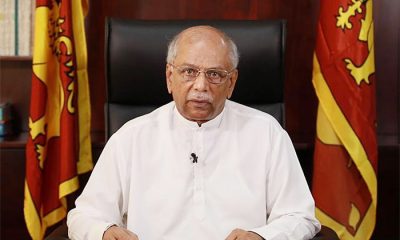Midweek Review
Sri Lanka’s foreign policy dilemma
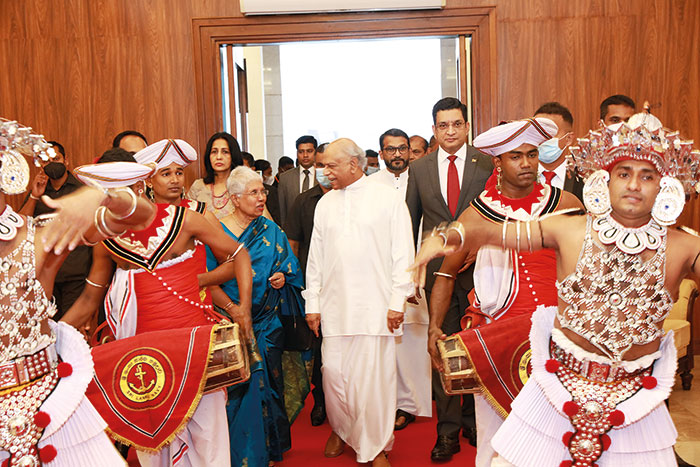
Bankrupt Sri Lanka is caught up in a China-US battle. The situation has been further complicated by India, Japan and Australia becoming part of the US-led military alliance meant to counter China. The US-led grouping is hell-bent on enhancing its influence in Colombo as both parties woo lawmakers. Recent declaration by the ruling party that the USD 2.9 bn IMF loan facility would be in jeopardy unless Parliament enacted the 21st Amendment to the Constitution is nothing but a severe warning to Parliament. Should Constitutional Amendments be subjected to foreign interference?
By Shamindra Ferdinando
Previous Canadian High Commissioner in Colombo, David McKinnon, in May this year, ridiculed the political party system here. Obviously referring to the rapidly developing political crisis in the wake of the unprecedented eruption of public anger at the then President Gotabaya Rajapaksa on March 31,
McKinnon tweeted: “Every day I am reminded that #SriLanka sets the gold standard for political humour. Maybe there’s a way to monetize this as an export? @TheDailyShow.” The Canadian sarcastically used the tag of the popular US political comedy “The Daily Show.”
McKinnon took over the Canadian mission here, in late Oct 2017, a couple of weeks after Ravi Karunanayake was forced to give up the Foreign Ministry portfolio, following shocking disclosures like him claiming that he didn’t know who was paying for the luxury penthouse he and his family were occupying, during the Presidential Commission of Inquiry that probed into Arjuna Mahendran affair (Central Bank Treasury Bond scams). McKinnon’s five-year term here ended in early Oct. this year. At the time McKinnon presented credentials on Oct. 23, 2017, Maithripala Sirisena served as the President.
We wonder what the Canadian would have to say about finding remains of native children in more than 2000 unmarked graves on the grounds of Church-run schools, in Canada, where they had been forcefully taken from their homes to learn white man’s “civilised” behaviour. Perhaps, some of those children would have been molested/raped by sex maniacs who were their state appointed guardians and killed to prevent the truth coming out. Canada/UNHRC where are the independent probes by international judges into such crimes committed.
Five years later, Sirisena returned to Parliament as an ordinary member whereas Ranil Wickremesinghe, who served as the Prime Minister at the time McKinnon arrived in Colombo, received the outgoing envoy at the Presidential Secretariat late last month.
It would be pertinent to mention that McKinnon chided political party system here three days after UNP National List MP Wickremesinghe received the appointment as the Premier. Beleaguered President Gotabaya Rajapaksa had no option but to invite Wickremesinghe in the wake of Samagi Jana Balavegaya (SJB) leader Sajith Premadasa turning down the invitation.
There had not been a previous instance of a foreign envoy making such derisive remarks publicly . As a member of the UK-led Sri Lanka Core Group at the Geneva-based United Nations Human Rights Council (UNHRC), Canada played quite an active role against Sri Lanka.
However, there is no point in finding fault with Canada for Sri Lanka’s continuing failure to set the record straight. The Foreign Ministry cannot absolve itself of the responsibility for Sri Lanka’s pathetic response to war crimes accusations. At the recently concluded 51 Geneva sessions, a section of the international community expanded the ‘charge sheet’ to include economic crimes.
Where are the modern day equivalents of the likes of Shirley Amarasinghe, Chris Pinto, Vernon Mendis, Izeth Hussain or even non-career, but highly talented longtime ambassador Neville Kanakaratne, to name a few, who could stand up to defend Lanka’s interests, being second to none in the world when called upon to do so. Minister Sabry serving as a one-man defence team, won’t do, unless the Foreign Service was fully geared to take up that task. We are certain there are very capable officers in our Foreign Service, even among those who got in with influence, and Minister Sabry must make it a point to nurture such talented officers and protect them from the cabal that calls the shots at the Ministry.
Foreign Minister Ali Sabry, PC, had to respond to the latest diatribe against the country and he rightly questioned the legitimacy of Geneva’s approach. Perhaps Sabry, hadn’t taken into consideration his own criticism of the government set up that caused the economic fallout. In June, this year, Sabry explained how those who had been responsible for overseeing the country’s finances ruined the national economy. The Minister identified them by positions held at that time (Dr. PBJ, Secretary to the President and longtime monetary honcho, Prof. W.D. Lakshman, Governor, Central Bank and economic guru, Ajith Nivaard Cabraal, Governor, Central Bank and S.R. Attygalle, Secretary to the Treasury.)
The economy has deteriorated to such an extent and the country trapped in a deepening political-economic-social crisis, the Wickremesinghe-Rajapaksa government seems in a catch-22 situation. Former MP and one-time Sri Lanka’s Ambassador in Tehran, M.M. Zuhair, PC, recently discussed the ongoing crises against the backdrop of Sri Lanka’s readiness to accept foreign help to probe the 2019 Easter Sunday carnage and continuing refusal to allow foreign investigations into alleged war crimes claimed to have been committed when the security forces crushed the hitherto considered invincible LTTE in the battle field against the advice of the West. The former Senior State Counsel addressed these issues taking into consideration the stand taken by Muslim majority nations at the UNHRC this year. Zuhair pointed out those Muslim majority nations refrained from supporting Sri Lanka for the first time at the UNHRC 51st sessions, Zuhair also warned that these countries were likely to vote against Sri Lanka at the next opportunity.
BIDTI event
Bandaranaike International Diplomatic Training Institute (BIDTI) recently held its 24th Convocation with the participation of Prime Minister Dinesh Gunawardena, who held the Foreign Affairs portfolio, under President Gotabaya Rajapaksa, and incumbent Foreign Minister Sabry, an SLPP National List MP. State Minister for Foreign Affairs Tharaka Balasuriya and Foreign Secretary Aruni Yasodha Wijewardena were among the invitees.
There had been two groups of students (2019/2020) and (2020/2021) at the 24th Convocation as the previous one was held in the second week of August 2019, in the run-up to the presidential election. The then Prime Minister Ranil Wickremesinghe had been the Chief Guest while Foreign Minister Tilak Marapana, PC, and Foreign Secretary Ravinatha Aryasinghe joined the UNP leader in presenting awards and certificates. the Foreign Minister is the Chairman of the Board of Management of the BIDTI.
Between the 23rd and 24th BIDTI Convocations, an utterly corrupt political party system has bankrupted the country. The economic crisis should be examined taking into consideration the political chaos caused by the disintegration of the recognized political party system. The parliamentary politics is now in such a confused and pathetic state, lawmakers, representing 15 political parties therein, are pulling in different directions. Of the 225-member Parliament, President Wickremesinghe’s UNP is represented by one
National List MP (Vajira Abeywardena) whereas Premier Gunawardena’s MEP group consists of three MPs (PM, Sisira Jayakody and PM’s son, Yadamini). Yadamini Gunawardena represents the SLPP National List. MEP contested the last general election on the SLPP ticket.
Maithripala Sirisena’s SLFP has been reduced to 14 MPs, and half of them have switched their allegiance to President Wickremesinghe.
Perhaps, the top management of the BIDTI should have invited the Governor of the Central Bank, Dr. Nandalal Weerasinghe, to educate those who received recognition at the 24th Convocation. The intrepid banker could have briefed them of the ground situation the way he told the Parliament, on August 31, how the political party system ruined the country.
If Sri Lanka is genuinely interested in developing a skilled Foreign Service, unwarranted political interferences must also be stopped forthwith. Political parties, represented in Parliament, should end the despicable practice of approving heads of missions. The High Posts Committee, headed by the Speaker, has become just a rubber stamp with those near and dear to the powers that be receiving ambassadorial posts as by birth right. The whole process, in spite of criticism by sections of the media, continued unabated over the years, with tacit understanding of the government and the Opposition.
The Foreign Service lacked the required strength to stand up to political machinations. There cannot be a better example than when Tamil National Alliance (TNA) heavyweight M.A. Sumanthiran declared, in Washington, a tripartite agreement among the US, Sri Lanka and the TNA regarding hybrid war crimes court in the presence of Sri Lanka’s Ambassador in Washington Prasad Kariyawasam.
That was in 2016. The top career diplomat returned to Colombo, the following year, to receive appointment as the Foreign Secretary. Following his retirement, Kariyawasam moved to Parliament as an Advisor to the then Speaker Karu Jayasuriya. Kariyawasam paid for by the USAID! The endowment shouldn’t have surprised anyone against the backdrop of Kariyawasam’s role in approving ACSA (Access and Cross Servicing Agreement) in early August 2017. The USAID enhanced its role here during the Yahapalana administration with the launch of a Rs 1.92 bn partnership (USD 13 mn) meant to strengthen accountability and democratic governance. It should be stressed that during the Yahapalana administration, Sri Lanka secured ISBs (International Sovereign Bonds) amounting to approximately USD 12.5 bn, one of the major causes of thr current economic crisis. As to what they did with that money is anybody’ s guess as they hardly undertook any major development projects, unlike the Rajapaksas’, whose hallmark was grandiose projects. May be future generations will judge Rajapaksas, particularly Mahinda and Gotabaya, differently like us now appreciating our ancestors for building the great tank civilization and cities like Anuradhapura, Polonnaruwa or even Sigiriya.
Even achievements of Field Marshal Sarath Fonseka, who can be easily called the type of general who only appears once in a couple of thousand years, as someone has said, have got negated because of his short fuse and short sighted politics.
The SJB has been largely silent on the issue at hand for obvious reasons. The JVP has repeatedly pointed out how the UNP-led Yahapalana government pursued an extremely risky economic strategy at that time. The UNP and its breakaway faction, now registered as SJB, definitely owed an explanation.
A daunting challenge
Sri Lanka should undertake a comprehensive study on the 2015 Geneva accountability resolution. The BIDTI can be part of the group assigned to embark on the study as Geneva steps up the offensive. Dinesh Gunawardena, in his capacity as the Foreign Minister, at the March 2020 Geneva sessions famously announced Sri Lanka’s decision to withdraw from the Geneva process.
Unfortunately, though much was expected from Prof G.L. Peiris, as the successor Foreign Minister, with his photographic memory, but hardly anything has changed at that Ministry during his tenure to clear up the mess there.
Sri Lanka’s Geneva statement was made a month after the US declared a travel ban on General Shavendra Silva, the then Commander of the Army and Acting Chief of Defence Staff (CDS).
Unfortunately, the Foreign Ministry, under different political leaderships, never sought to set the record straight. Instead, it allowed the further deterioration of the situation. On the basis of failing to challenge the unsubstantiated war crime allegations, yet to be verified in a court of law, Western powers have taken punitive measures against selected retired and serving officers, who are the true living heroes of this country. War-winning Army Chief Field Marshal Sarath Fonseka is among them. When the writer raised this issue with Foreign Minister Sabry, at a media briefing ahead of the Geneva sessions, the President’s Counsel stressed that the entire fighting Divisions have been categorized.
Tangible actions are necessary to have the accusations countered and the war-winning armed forces cleared of wrongdoing. Instead, successive governments quite conveniently allowed the situation to deteriorate. The British steadfastly refused to accept their own independent version of the Vanni military action, despite Lord Naseby disclosing in the House of Lords in Oct. 2017 the existence of such official records that effectively debunked war crimes allegations.
Sri Lanka never really pushed the British on this matter as the latter pursued a hostile campaign against Sri Lanka at the UNHRC. The UK’s rejection of their own diplomatic cables should be examined, taking into consideration similar US refusal to accept Colombo-based Defence Advisor Lt. Colonel Lawrence Smith’s public declaration in June 2011 that the Sri Lanka military didn’t perpetrate war crimes during the last phase of the offensive, to defeat the LTTE. In fact, the Foreign Ministry never really wanted to counter accusations in a systematic way. The Foreign and Defence Ministries never acted in unison as those responsible pursued their own agendas, much to the disappointment of the armed forces.
The case of Imaad Shah Zuberi, 50, revealed how the war-winning government outsourced Foreign Ministry responsibilities, possibly due to its known ineptness, to an American venture capitalist and political fundraiser who was sentenced on Feb 18, 2021 to 144 months in federal prison. U.S. District Judge Virginia A. Phillips found him guilty for fabricating records to conceal his work as a foreign agent while lobbying high-level U.S. government officials, evading the payment of millions of dollars in taxes, making illegal campaign contributions, and obstructing a federal investigation into the source of donations to a presidential inauguration committee.
Zuberi of Arcadia, California, was also ordered to pay $15,705,080 in restitution and a criminal fine of $1.75 million.
This criminal waste of funds took place during the tail end of Mahinda Rajapaksa’s second term. The payments were made by the Central Bank. Sri Lanka never bothered to examine this case. Who authorized the hiring of Zuberi?
Let me reproduce a relevant section of a statement issued by the US Department of Justice on Feb 18, 2021, that dealt with Zuberi’s case. It was titled ‘Political Donor Sentenced to 12 Years in Prison for Lobbying and Campaign Contribution Crimes, Tax Evasion, and Obstruction of Justice.’ The following is the section that dealt with Sri Lanka: “In addition, the government of Sri Lanka hired Zuberi in 2014 to rehabilitate the country’s image in the United States, which had suffered because of allegations that its minority Tamil population had been persecuted. Zuberi promised to make substantial expenditures on lobbying efforts, legal expenses, and media buys, which prompted Sri Lanka to agree to pay Zuberi a total of $8.5 million over the course of six months in 2014. Days after Sri Lanka made an initial payment of $3.5 million, Zuberi transferred $1.6 million into his personal brokerage accounts and used another $1.5 million to purchase real estate.
In total, Sri Lanka wired $6.5 million pursuant to the contract, and Zuberi used more than $5.65 million of that money to the benefit of himself and his wife. Zuberi paid less than $850,000 to lobbyists, public relations firms and law firms, and refused to pay certain subcontractors based on false claims that Sri Lanka had not provided sufficient funds to pay invoices.
Relatedly, Zuberi failed to report on his 2014 tax return millions of dollars in income he received from the Sri Lankan government. While his 2014 federal income tax return claimed income of $558,233, Zuberi failed to report more than $5.65 million he received in relation to the Sri Lanka lobbying effort. Zuberi’s tax evasion over the course of four years – 2012 through 2015 – caused tax losses ranging from $3.5 million to as much as $9.5 million.”
In a sense Mahinda Rajapaksa was like a drowning man facing the might of the West, led by the US and the UK, so they literally clutched at proverbial straws to escape drowning. They also trusted the wrong people, like Namal foolishly spending on a ‘nil balakaya’ thinking that would be his rallying force.
In the following year, at the behest of the US, the Yahapalana regime betrayed its armed forces at the UNHRC. The Geneva process is apparently still on track though Gotabaya Rajapaksa’s administration declared in 2020 that it withdrew from the 2015 UNHRC resolution.
The Rajapaksa administration never accepted responsibility for this criminal waste of money on foolish lobbying efforts. The then Central Bank Governor Ajith Nivard Cabraal denied his responsibility. The Parliament should have inquired into this matter. Alas, Parliament has pathetically failed not only in its primary responsibilities-ensuring financial discipline and enactment of laws but overall supervision of key sectors, including foreign affairs.
Against the backdrop of the US court verdict on Zuberi, Sri Lanka suffered another humiliation when a US court in July this year sentenced Sri Lanka’s former ambassador to Washington and Rajapalsa kinsman to a US$5,000 fine and two years’ probation.
Former President Mahinda Rajapaksa’s cousin Jaliya Chitran Wickramasuriya pleaded guilty to diverting and attempting to embezzle US$332,027 from the government of Sri Lanka, as it purchased a new embassy building in Washington in 2013.
“Even though this was not millions of dollars, it represents a serious theft from the people, and by a person that they entrusted to represent their interests in the capital of the most powerful country in the world,” said Judge Tanya S. Chutkan. “What you have done is a serious betrayal.”
Udayanga Weeratunga, another cousin of the ex-President, served as Sri Lanka’s ambassador in Moscow from 2006 to 2015. Standard restrictions that applied to other heads of missions didn’t apply to Wickramasuriya and Weeratunga because of their relationship with the Rajapaksas. Unfortunately, the Sri Lankan style in handling foreign affairs, whoever is in power hasn’t changed. The country has paid a huge price for hurting Japan and Russia over the abrupt cancellation of the Light Train Transit (LRT) Project in Sept. 2020 and detention of Aeroflot flight in June this year. The Yahapalana government (2015-2019) caused a major crisis by antagonizing China when it halted the Colombo Port City project and making unsubstantiated allegations pertaining to Chinese loans. The recent furore over Sri Lanka suddenly denying Chinese research vessel access to Hanbantota port after having earlier okayed it, controversy over Chinese organic fertiliser shipment that had to be settled by paying China USD 6.7 mn and official ‘interference’ in Indian liquid fertiliser purchases underscored the fragility in the systems in place.
Features
AKD faces challenging year ahead
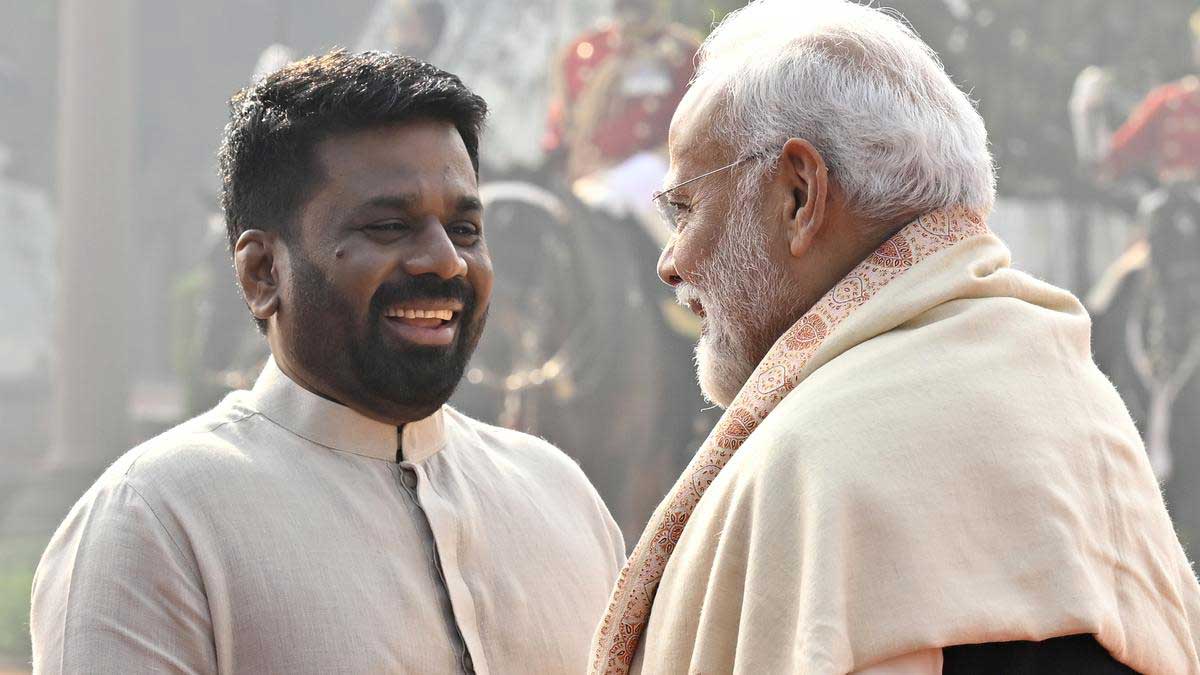
By Shamindra Ferdinando
Senior lecturer in economics and head of the IT Department at the University of Colombo, Professor Priyanga Dunusinghe, recently declared that the new National People’s Power (NPP) administration had neither a clear economic policy nor a tangible action plan to address the plethora of serious issues facing the nation.
Prof. Dunusinghe warned of dire consequences unless the government took meaningful measures to overcome the challenges.
Appearing on Derana, the outspoken academic claimed that the investors and the public were in the dark as to the overall government economic policy. Asserting that the NPP government now primarily addressed the day-to-day issues, Prof. Dunusinghe alleged that economic reforms required to stabilize, consolidate and strengthen the economy weren’t being implemented. Therefore, the government seemed to be already late in that regard.
Obviously Prof. Dunusinghe summed up the situation on the economic front quite accurately. The academic seemed to have contradicted former President and UNP leader Ranil Wickremesinghe who had both publicly and privately applauded President Anura Kumara Dissanayake’s economic policy recently. It could be a case of him wanting to appease NPP as he, too, has many a skeleton in his cupboard, like the bond scams or the precipitating of the ongoing debt crisis by borrowing as much as USD 12 billion from the international bond market, at high interest, without having achieved anything tangible to show with such high borrowings, all during the Yahapalana rule or misrule.
Readers should always remember Mahinda Rajapaksa and his team fought a debilitating war to a finish against the world’s most ruthless terrorist outfit, the LTTE, and defeated it against the predictions of all types of pundits, while at the same time kept the economy humming and completed some impressive infrastructure projects, like building a brand new international harbour and an airport, among so many other achievements. Need we say more?
No doubt there were some utter mistakes that can be directly attributed to some of his close relatives he had around him, but Mahinda never betrayed the country. For that matter, who is infallible in this world? The bottom line reveals only one thing that is, he was the best leader to pull the country out of the rut we were in at the time.
President Dissanayake also holds the Finance portfolio, in addition to Defence. In terms of the Economic Transformation Bill, approved by Parliament on July 25, 2024, without a vote, the NPP government has no option but to adhere to the Act. Prof. Anil Jayantha Fernando is the Deputy Finance Minister.
The agreement with the IMF, negotiated by Wickremesinghe and accepted by Dissanayake, in his capacity as the President, is the basis for the controversial Act. In spite of attacking the Economic Transformation Bill, the then Opposition conveniently refrained from seeking a vote on the Bill.
Prof. Dunusinghe has been always forthright in his criticism of questionable economic matters, regardless of who wielded the political power. The government should take such criticism seriously as the overall situation remained volatile though the parliamentary Opposition seems wholly inadequate and indifferent to the challenges ahead.
The pathetic and shoddy handling of severe shortage of rice in the open market badly exposed the government. What really surprised the hapless public is the NPP’s thinking the ‘Rice Mafia’ can be reined in by the issuance of gazettes. The NPP basically repeated President Gotabaya Rajapaksa’s strategy by declaring price controls on essential commodities, like rice, by issuing gazettes. The NPP placed Nadu, Samba and Keeri Samba at Rs 230, Rs 240 and Rs 260 respectively a couple of weeks ago, following talks with rice millers, but it didn’t make any difference.
During the debate over the failed bid to control the private sector running the show, as it pleases, it was revealed that one of the biggest rice dealers in the country and identified as one of those who had been accused of earning unconscionable profits at the expense of the suffering people is on the National List of the SJB though he didn’t get an opportunity to enter Parliament this time. How did he end up in the SJB National List?
The NPP appeared to be making the often repeated mistake committed by previous governments in believing in the strength of their parliamentary group. In the face of public anger caused by wrong decisions, very often even such monolithic parliamentary groups crumble under pressure. The NPP wouldn’t be an exception unless it quickly realized and addressed the shortcomings.
Real challenge outside Parliament
The situation in Parliament is deceiving. It may give the NPP a somewhat false sense of security. Having handsomely won the presidential election in Sept, 2024 by polling 5.7 mn votes, though he couldn’t obtain 50% plus 1 vote, Anura Kumara Dissanayake consolidated the NPP’s position with a staggering 2/3 majority at the parliamentary election in Nov, 2024.
The NPP increased its tally to 6.8 mn votes from 5.7 mn polled at the presidential. Both the executive and the legislature are in the NPP’s hands. The main Opposition Samagi Jana Balawegaya (SJB) has been reduced to just 40 seats against the NPP’s 159 and down to just 1.9 mn votes at the parliamentary election. The SJB performance is nothing but pathetic.
The dismal results at the national elections had made the Sri Lanka Podujana Peramuna (SLPP) that obtained a staggering 145 seats at the 2020 general election irrelevant with their tally reduced to just three seats in the current Parliament.
But, the NPP cannot be lulled into a false sense of security, under any circumstances, as the real challenge is not the Opposition but the promises made by the party to the masses for a system change in the run-up to the presidential and parliamentary elections. That is the undeniable truth. Having come to power as an all-knowing lot, the NPP leadership will have to answer for developments, come what may.
The recent declaration that those earning a monthly salary up to Rs. 150,000 would be exempted from the PAYE (Pay As You Earn) tax to please professionals and at the same time announced the increasing of the withholding tax on fixed deposit interest to 10 percent from 5 percent, thereby hitting those living on already depleted interest incomes below the belt, underscored the crisis the country is in.
President Dissanayake, in his capacity as the Finance Minister, told Parliament on Dec. 18 that this was done in line with a fresh agreement reached with the IMF. In other words, in spite of the change of government and their severe criticism of Wickremesinghe’s policies, the NPP is also on the same track.
The bottom line is that Sri Lanka’s economic direction is firmly in the hands of the IMF and whatever the NPP leaders uttered to the contrary from election platforms to impress the public in the run up to national elections, the government will have to toe the IMF line when it presents a formal Budget in February for the next financial year.
An interim Budget/vote on account covering the first four months of 2025 was approved in Parliament on Dec. 06, 2024 without a vote, at the end of a two-day debate.
Deputy Finance Minister Fernando told Parliament that the delay in debt restructuring, over the last two years, had cost the country an additional USD 1.7 billion in accumulated interest.
Fernando is on record as having said: “We are hoping to complete the restructure of the bilateral debt and international sovereign bonds by December 31.”
The interim Budget would cover the cost of debt servicing and the government expenditure for the first four months of next year. The NPP government has assured the international community that it would continue to honour the international commitments on debt restructuring commenced by the predecessor Wickremesinghe’s government.
Ground realities
During the presidential election campaign followed by the general election, the NPP talked as if it could address issues that plagued Sri Lanka over the past decades. However, over three months after the presidential election, the public now realize that the NPP had no magic wand in its hand and some issues can never be settled.
Of course, some of those who exercised their franchise in support of the NPP at the two national elections are deeply worried and disappointed. But, the fact remains that those who exercised political power had been appropriately dealt with by the electorate and they wouldn’t be in a position to regain public confidence within a short period. That is the reality those who represent the SJB and NDF (National Democratic Front) had to contend with.
It would be pertinent to mention that two of the oldest political parties in the country, namely the UNP and the SLFP, are not even represented in the current Parliament. The UNP and SLFP leaderships are baffled, but that wouldn’t make things easy for the NPP, regardless of its numerical unconquerable position in Parliament. So did the previous Gotabaya Rajapaksa government that was ousted by violent street protests, most probably staged managed from abroad.
Let me briefly discuss the huge challenge faced by Sri Lanka in dealing with large scale poaching carried out relentlessly by the Tamil Nadu fishing fleet in addition to them destroying fish stocks here by bottom trawling. The joint statement issued following talks between President Dissanayake and Indian Premier Narendra Modi quiet clearly indicated that New Delhi wants Sri Lanka to turn a blind eye to the ongoing rape of fishery resources belonging to the people here.
President Dissanayake raised the massive destruction caused by bottom trawling practised by the Tamil Nadu fishing fleet but the joint statement and the comments made by the Indian Foreign Secretary Vikram Misri on this issue at a special briefing indicated in no uncertain terms that India wouldn’t under any circumstances take necessary measures to prevent Tamil Nadu fishing fleet crossing Indo-Lanka maritime boundary.
India seemed to be hell-bent on allowing destructive fishing practices in Sri Lankan waters though it doesn’t allow the same in their territory.
India often emphasises the responsibility on the part of all concerned to deal with poachers in a humanitarian manner. The joint statement went a step further. Referring to the talks, Premier Modi had with President Dissanayake on Dec 16, 2024, the joint statement declared the two leaders ‘underscored the need to take measures to avoid any aggressive behaviour or violence. Would it be fair to pressure Sri Lanka, now beholden to New Delhi for swift economic assistance provided during 2022 and 2023 crisis period, to allow poaching?
How could there be a mutually acceptable solution to the poaching issue when the Indo-Lanka maritime boundary is being violated almost on a daily basis? Although the joint statement referred to the matter at hand as fisheries issues it is nothing but poaching sanctioned by the centre in India.
The joint statement, however, gave the game away when it asserted that the issue should be dealt with taking into consideration, what it called, the special relationship between India and Sri Lanka.
Hats off to President Dissanayake for taking up two related issues at a joint media briefing addressed by him and Premier Modi. A statement issued by the Presidential Media Division (PMD) quoted the NPP and JVP leader as having said that he requested Premier Modi to take measures to stop bottom trawling that caused irreparable ecological damage and also curb illegal, unreported and unregulated fishing (IUU fishing). President Dissanayake also reminded them that bottom trawling is banned in both countries. The President took up the position, therefore tangible action should be taken to stop bottom trawling.
But Indian Foreign Secretary’s response to Sachin Vadoliya of UNI query on President Dissanayake’s request pertaining to bottom trawling and IUU fishing revealed that New Delhi had no intention of addressing the issues at hand. The Foreign Secretary conveniently interpreted President Dissanayake’s comments as meaning the Sri Lankan leader calling for the problem to be solved by both countries together.
The supreme irony is that India exploited the situation to its advantage. The ongoing bid to formalize poaching by the Tamil Nadu fishing fleet under the pretext of some bilateral agreement cannot be condoned under any circumstances.
While declaring New Delhi’s immediate readiness to finalize what Premier Modi called a Security Cooperation Agreement, Sri Lanka is being asked to allow rape of its fish resource. The Illankai Thamil Arasu Kadchi (ITAK), the largest Tamil political party that represented the Northern and Eastern regions remained unsure of its stand on the fisheries issue.
The ITAK must take a clear stand on this problem. But, the NPP, having secured the highest number of seats in the Northern and Eastern regions at the expense of the ITAK at the recently concluded general election, needs to represent the interests of the Tamil fishing community here.
Resumption of debt repayment
The primary challenge faced by President Dissanayake is nothing but preparing the economy over the next four years to restart paying the massive foreign debt owed by the country in 2028. The government’s capacity to meet this particular challenge should be examined taking into consideration Prof. Dunusinghe’s criticism of the NPP’s economic plans.
Sri Lanka, in April 2022, made a unilateral statement on stopping debt repayment. Regardless of promises made during the presidential and parliamentary poll campaigns, the NPP is slow in taking tangible measures to revive the sick economy. The absence of long queues at fuel and gas stations doesn’t mean Sri Lanka is out of the woods yet.
Unfortunately, the Opposition is waiting for problems created by previous administrations to overwhelm the NPP. Having declared that the NPP administration couldn’t last for not more than a couple of months, the Opposition realized that their only salvation is the NPP causing its own downfall.
Perhaps, the NPP should reveal its stand on accusations that the failure on the part of the Parliament to amend the Foreign Exchange Act No 12 of 2017 that allowed unscrupulous people to park billions of US dollars overseas.
Various politicians have given different figures in this regard. Then MP Gevindu Cumaratunga estimated the total amount parked abroad owing the lacuna in the Act at USD 36 billion. His colleagues Wimal Weerawansa and Vasudeva Nanayakkara, too, agreed with the figure declared by Cumaratunga.
Former Justice Minister Dr. Wijeyadasa Rajapakse, PC, estimated the amount of funds parked overseas to be over USD 50 billion. Interestingly, he was among those who voted for repealing the old Act that ensured that exporters brought back export proceeds within a stipulated time period.
The Yahapalana administration repealed the time-tested Exchange Control Act of 1954 at the behest of the then Premier Ranil Wickremesinghe who refrained from voting for it.
The NPP never addressed this issue during campaigning. The NPP also owes the country an explanation as to why the price of a litre of 92 Octane couldn’t be further reduced as during the campaign the then Power and Energy Minister Kanchana Wijesekera was repeatedly accused of taking kickbacks at the expense of consumers.
So far, a litre of Octane 92 has been reduced to Rs 309 from 311 by the NPP. The government has also earned the wrath of the public for putting off the stipulated electricity price revision at a time much of the electricity is generated by hydro power stations at low cost.
The government seems caught in a vortex of problems-ranging from never ending problems faced by the farmers to Indian and US pressure to extend the moratorium on foreign research vessels visiting Sri Lankan ports. The moratorium declared by Wickremesinghe for a period of one year 2024 ended yesterday (Dec 31, 2024). Would it be extended, to allow Chinese vessels to resume visits or would some committee be appointed to take time to appease India, while Sri Lanka sought to reach some sort of understanding with China.
Features
Photography: A Primitive Theatre

BY Saumya Liyanage
(Text of a keynote address delivered at the annual Diploma Certificate Award Ceremony, organised by the National Photographic Art Society, Sri Lanka, on the 26 October 2024)
When a photograph of the main protagonist, Joseph, in the play Antique Kadayaka Maranayak (‘Death in an Antique Shop’), written and directed by Asoka Handagama, was shared on Facebook, a much awaited discussion erupted among theatregoers on how this image captured the true essence of the play. The playwright and director Handagama had also commented on Facebook, stating that the photographer, Sagara Lakmal de Mel, has captured the ‘full coverage of the play’ (Handagama, Facebook, 4th June 2023). This statement and the comments received for the Facebook post aroused a question of how photography links with theatre. How could a still image depict the essence of a play? Why is a still image of a play so important for us to understand the nature of acting, mise en scène, and other aspects of theatre?
Theatre photography has not been a major interest of the Sri Lankan photographers who capture the actors’ work on stage. It is very seldom that theatre productions are being captured by photographic documentation with a purpose of archiving and research. Photographers who are involved with theatre productions very often think of documenting theatre performances for the sake of documenting the “event” rather than systematically capturing the essence of the live performance. This paper therefore intends to explore the affinity between photography and theatre. Though these two art forms seem categorically different from each other, this short write-up attempts to suggest a convergence between these two art forms or, rather, sheds light on how these two art forms can be intermingled.
One of the fundamental questions that triggered my mind on photography is why photography is important for us to consider as a reflection of our own world and time. Some of the key features of photography include providing us with memories, preserving the past and our human and natural histories, capturing what we perceive as reality around us, and representing the lives of both humans and animals. Some experts say that photography captures time, memory, duration, presence, love, loss, mourning, and nostalgia. I am aware that photography is an industry. It is a commercial industry where people can make lots of money out of it. However, my question does not comply with the photographic industry but is directed towards the art of photography or the “ontological desire” of photography.
As an actor, I have been fascinated by the presence, absence, and the embodiment of meanings in images. In theatre arts, presence and absences are key elements in a live performance. As Peggy Phelan argues, ‘Performance’s only life is in the present […] The document of Performance […] is only a spur to memory, an encouragement of memory to become present’ (Phelan 1993, p. 146). The nature of live theatre is thus always ephemeral. But photography captures images and preserves them in a particular time and space. However, in terms of its presence and absence of images, photography shares the same phenomenological implications with theatre.
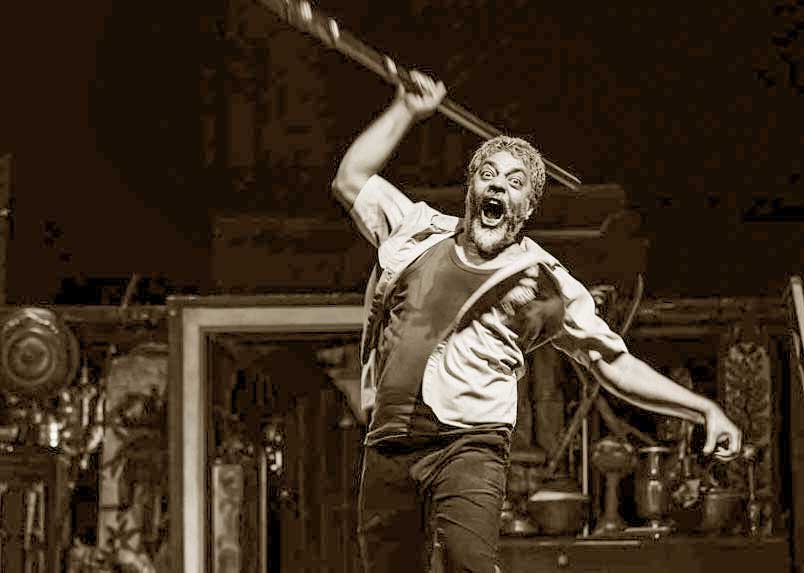
This image of Saumya Liyanage in the play Antique Kadayaka Maranayak (Death in an Antique Shop), shared on Facebook, provoked debate. Photo credit: Sagara Lakmal de Mel.
It is vital for me to emphasise the phenomenological implications of photography because the young generation of photographers should at least be aware of the breadth and depth of the art they use. As you may know, one of the classical writings on photography is Camera Lucida: Reflections on Photography, written by French philosopher and semiotician Roland Barthes. In this collection of essays, Barthes articulates his ideas on photography and shows us how the majority of theorists see resemblances between photography and paintings. However, Barthes argues that photography is more directly linked with theatre than visual art or painting. ‘Photography is a kind of primitive theatre, a kind of Tableau Vivant, (a tableau vivant is a static scene containing one or more actors or models), a figuration of the motionless and made-up face beneath which we see the dead’ (Barthes, 1993, pp. 31-32).
After watching Brecht’s play Mother Courage and Her Children in Paris, Barthes wrote an important paper titled ‘Seven Photo Models of Mother Courage.’ In this essay, Barthes had selected seven photographs taken during the staging of Mother Courage. During this performance, a photojournalist named ‘Pic’ had taken a series of photos using a telephoto lens that captured the vital moments of the play. Another essay written by Barthes titled “Diderot, Brecht, Eisenstein” (1973) further widened his discussion about the value of photography in analyzing mise en scène of the play.

German Actor, Helen Weigal’s ‘Silent scream’ in Mother Courage and Her Children by Bertolt Brecht. The image was captured by a photojournalist in 1957 when Berliner Ensemble staged the play for the second time in Paris.
Barthes argues that when studying Brecht’s plays, it is important to focus on the “Pregnant Moments” of the scenic situations. Photography as a medium of capturing these “Pregnant Moments” is vital to understanding the tableaux. ‘In so doing, photography would function as a technology for the recording of the tableaux created by the playwright /metteur-en-scène’ (Carmody, 1990, p. 31). When studying Brecht’s plays, this tableaux represents Brecht’s key concept of gestus (a gesture, or a set of gestures that can be read as a social demeanor of a character).
The idea of Tableau Vivant is vital for us to further understand how this still photograph is linked with theatre and its theatrical presence. Theatre is performed in a particular space and time, with actors and additional auxiliary arts such as costumes, sets, lighting, and makeup. Thus, theatre is a series of photographic images, connected to each other as ‘animated photographs’ revealing human behaviour within the chosen time and space. The photographic frame is replaced in theatre by the proscenium arch, limiting our perception within the given scenic situation. Even though theatre showcases animated human figures and objects, it is a series of imagery in which the frozen images of humans and other objects are placed and choreographed to make meaningful situations. As Barthes suggests, photography is thus a “primitive theatre,” a tableau of human figures, and also a “made-up face” beneath which we see the “dead” (ibid, 1993).
How do we understand Barthes’ analysis of tableau figures in photographs as the representation of death? Barthes uses a metaphor here to discuss how the subjects in photographs represent death by referring to traditional Asian dance dramas such as Noh, Kabuki, and Kathakali. In these traditional theatres, actors appear with heavy makeup and costumes. In most of the traditional shamanic performances, the shaman represents both the death, demonic spirits, and the living at the same time. The Sharman also appears in front of the audience, the villagers with the painted faces signifying his performative nature of living and the dead.
Thus, Barthes concludes that the human tableau figures presented in photographs are similar to Sharman, who perform death and being with living on the same plain. Now, for me, photography is something theatrical and performative through which the photographer animates her/his figures in the stillness. Photographs present performative elements through their objects and animate them in our perceptual world. Though they appear as still images, they are masked with dead as Barthes postulates and ignite certain referents and generate meanings. As I have argued, theatre and photography are interrelated arts. There are many scholars who have studied the convergences of theatre and photography, and at the same time, philosophically there are some differences pertaining to these forms of art (Carmody, 1990). It is clearly evident that photography has been an integral part of the development of modern theatre. Scholars who have studied early 19th and 20th century modern theatre in the West and East have used photographic images as references to study the nature of theatre at the time. Photography thus has preserved the historical development of theatre and its culture in diverse countries and nations.
Today, we live in a world where photographic images are part and parcel of our daily realities. We all are, to some extent, photographers whose digital apparatuses are in action all the time. We all have the privilege of documenting and creating images of what we like and dislike. Further, we have the chance to display our images on various social media platforms. Our daily lives are becoming more and more visually transformed realities, and our narcissism is to capture our own lives and display them for the consumption of others. As Karel Vanhaesebrouck argues, ‘Not only is the impact of a camera fundamentally theatrical from the moment it selects a fragment of reality, but our society and its day-to-day organisation function along theatrical lines’ (Vanhaesebrouck, 2009).
References
Barthes, R. (1993). Camera Lucida: Reflections on Photography. London: Vintage Books.
Carmody, J. (1990). Reading Scenic Writing: Barthes, Brecht, and Theatre Photography. The Journal of Dramatic Theory and Criticism, 5(1), 25–38.
Barthes, R. and Bernays, H.F. (1967). Seven Photo Models of ‘Mother Courage’. TDR (1967-1968), 12(1), p.44. doi:https://doi.org/10.2307/1125292.
Vanhaesebrouck, K. (2009). Theatre, performance studies and photography: a history of permanent contamination. Visual Studies, 24(2), 97–106. https://doi.org/10.1080/14725860903106104
(Saumya Liyanage is an actor and professor in drama and theatre, currently working at the Department of Theatre Ballet and Modern Dance, Faculty of Dance and Drama, University of Visual and Performing Arts, Colombo.)
Midweek Review
Ex-SLN seniors focus on seabed mining and Sri Lanka’s claim for the delimitation of the Outer Continental Margin

Ambassador Majintha Jayasinghe, on Dec, 12, presented his Letters of Credence to Chinese leader Xi Jinping at the Great Hall of the People in Beijing. Jayasinghe was among several envoys who presented their credentials on that day.
During the presentation of the Letters of Credence, Ambassador Majintha Jayasinghe conveyed greetings from the President of Sri Lanka Anura Kumara Dissanayake and the people of Sri Lanka, to President Xi Jinping. President Xi reciprocated greetings to the President and the people of Sri Lanka. Addressing them, Jinping reiterated China’s readiness to share its development expertise and opportunities with other countries and promote the modernization of all countries, based on peaceful development, mutually beneficial cooperation, and common prosperity.
The above strategy has done wonders for Beijing as its windfall in Africa and elsewhere is leaving the traditional domineering states of the West literally in shock and awe, to borrow the words of former US President George W. Bush, who, of course, uttered those words in haste after the US invaded Iraq.
By Shamindra Ferdinando
Close on the heels of the conclusion of President Anura Kumara Dissanayake’s three-day official (Dec. 15-17) visit to New Delhi, the Indian High Commission here announced the planned visits by Indian Coast Guard vessels OPV (Offshore Patrol Vessel) Vaibhav and FPV (Fast Patrol Vessel) Abhiraj to Colombo and Galle, respectively.
According to an Indian HC press release, dated Dec. 20, OPV Vaibhav would be here from Dec. 23 to 27 and FPV Abhiraj from Dec. 29 to January 02, 2025.
As dinned into us over and over again by Indians, such visits, are meant to consolidate the friendship and interoperability between the two neighbouring friendly Navies in line with India’s SAGAR (Security and Growth for All in the Region) doctrine and ‘Neighbourhood First’ policy.
A day after the Indian HC statement on impending ship visits, the Chinese People’s Liberation Army Navy hospital ship ‘Peace Ark’ arrived in Colombo on a formal visit. The vessel is scheduled to leave Colombo on Dec. 28. Regular Indian and Chinese ship visits underscore the continuing tussle between the two giants of Asia because of Sri Lanka’s failure to state its independent and non-aligned position vis-a-vis two nuclear powers and, for that matter, all powers. This had been the unequivocal policy of Sri Lanka, prior to 1977.
With regard to ship visits, the issue at hand is what to do with the one-year moratorium imposed on January 1, 2024, on foreign research vessels entering Sri Lankan waters. The National People’s Power (NPP) government, struggling to balance relations with China and India, has declared that a committee would decide on what Foreign Minister Vijitha Herath called a national policy framework regarding visits by foreign research vessels.
China tested Sri Lanka’s ban by sending Xiang Yang Hong 3 early this year. The Wickremesinghe-Rajapaksa government had no option but to deny it entry into the country’s exclusive economic zone much to the disappointment and anger of China.
In August 2022, the Yuan Wang 5 arrived at the Hambantota port. Shi Yan 6 docked at Colombo port in late Oct. 2023. On both occasions, New Delhi protested. The US sided with India.
During President Dissanayake’s visit, India took up the contentious issue of Chinese research vessels targeting India. Indian officials do not mince their words when they refer to Chinese research vessels as spy ships. However, we intend to pay attention to seabed mining and Sri Lanka’s claim for the delimitation of the Outer Continental Margin – two issues that required a consensual approach on the part of Sri Lanka. Unfortunately, irresponsible and reckless political parties here seemed to be blind to the challenges ahead.
President Dissanayake referred to one of the issues when he addressed the media, along with Premier Narendra Modi on Dec. 16, following delegation-level talks and restricted talks between the two leaders.
A statement issued by the Presidential Secretariat quoted Dissanayake as having said that he requested Prime Minister Modi’s intervention in convening early bilateral technical discussions pertaining to Sri Lanka’s claim to the United Nations Commission on the Limits of the Continental Shelf (UNCLCS) for the establishment of the outer limits of the continental shelf beyond Sri Lanka’s Exclusive Economic Zone.
Defence cooperation
An examination of the latest Indo-Lanka joint statement, and statements made by Premier Modi and President Dissanayake at the media briefing, press briefing given by Foreign Secretary Vikram Misri, and the earlier joint statement issued following the then President Ranil Wickremesinghe’s state visit to New Delhi, in late July 2023, revealed the expansion of the scope of the bilateral relations.
Defence seems to have received New Delhi’s attention in line with its overall strategy pertaining to Sri Lanka. While the joint statement declared that the two countries would explore the possibility of concluding a framework Agreement on Defence Cooperation, Premier Modi declared: President Dissanayaka and I are in full agreement that our security interests are interconnected. We have decided to quickly finalise the Security Cooperation Agreement. We have also agreed to cooperate on Hydrography.
One needs to go through the section under the sub headline ‘Strategic & Defence Cooperation’ to understand the status of the developing situation.
The Island sought the views of retired Navy Chief of Staff and one-time SLN’s Chief of Hydrographer and Joint Chief Hydrographer to the Government of Sri Lanka, Y.N. Jayarathna, regarding the latest developments.
How do you view the challenges faced by our country?
Challenges faced by Sri Lanka in dealing with India are at an all-time high, I must say. We have lived with India for 2500 years and we will continue to live with India for the next 2500 years for sure. And my opinion is that, if we need to understand one country more exclusively, it is India. Our problem has been our political masters, who, for their survival in the political jungle, have played the India card for their political survival. As long as we have this attitude among our political masters there will always be friction, but, mind you, Sri Lanka is all that India has in the neighbourhood. So this is a case of managing each other’s national interests in such a way not to create friction between us. Wisdom, Knowledge and definitely a wider 360-degree bird-eye view on matters maritime are, I would say the three most important pillars in today’s context.
Asked to explain proposed seabed mining and President Dissanayake’s request for Premier Modi’s intervention, the retired officer said that seabed mining and Sri Lanka’s claim for the delimitation of the Outer Continental Margin were two different processes interlinked to one document; the UNCLOS (United Nations Convention on the Law of the Sea). The UNCLOS created the International Seabed Authority (ISA) and the Commission on the Limit of Continental Shelf (CLCS) to look after two different aspects of the seabed; one to regulate the mining of seabed resources and the other to regulate the demarcation limits of the seabed ownership, the expert said.
“Let me first address the seabed mining as India has requested for the licensing of the seabed mining of Afnesy Nikitin seamount, after paying the due fees as indicated in the ISA webpages, the process started. However, when the ISA observed that the claimed area is under Sri Lanka’s claim made in 2009, they stopped the process till the claim is processed at CLCS. Therefore, it will stand as it is.
Then let me focus on the CLCS process for Sri Lanka’s claim: Sri Lanka was the 43rd State to submit, in March 2009, and our claim entirely based on a provision in UNCLOS called the Statement of Understanding (SoU). Under this SoU, the limitations applicable in constraining Coastal States to limit their claims at 350 Nautical Miles as per Article 76 of UNCLOS, is not applicable. That is the basis of including the SoU in the UNCLOS by Sri Lanka’s drafters at that time in the early 80’s. This is introduced to address the inequity of the States who are going to get deprived of claiming the seabed beyond their EEZ. Now the Continental Margin claims are for seabed only as it is not granting any rights on the water column!
India made their claim also in 2009 under Article 76 of UNCLOS, keeping rights to submit another at a later date. They are making their second claim submission on SoU. Sri Lanka also reserved the right to submit the second submission, and it is entirely under Article 76 of UNCLOS.
Meanwhile, the consultations Sri Lanka was having with CLCS, since 2009, has run into an issue as some of the members of CLCS are thinking that limitations of 350 nautical miles as per Article 76 UNCLOS should apply for SoU, too. We are engaging the CLCS for that and it will take some more years to decide as UNCLOS procedures are purely technical.
Although our media and even most of our opinion makers think that India issued their Oct. 2022 Note Verbal in relation to their Seabed mining they requested for Jan. 2024, I see it differently. In 2022 India ensured that they could go for SoU without limiting distances of 350 nautical miles. If CLCS gives a decision on SoU coming under the 350 nautical miles’ limit, then India stands to lose. So, it is up to both India and Sri Lanka to campaign collectively to emphasize the spirit of SoU for the States in the Southern Bay of Bengal.
Jayarathna is of the opinion that India, went for ISA for seabed mining in Afnesy Nikitin seamount in 2024 because they feared China would submit first.
Commenting on the proposed Security Cooperation Agreement, the naval veteran said that such agreements were required but we need not accept the Indian draft. “Let’s draft it ourselves. We should not be making another Taiwan here for India. And whether India is an opportunity or opposition, it is for us to decide. India will be going the way she wants, and we need to be wiser enough to make use of it.”
Admiral RW irked
Former Navy Commander Ravindra Chandrasiri Wijegunaratne, however, bluntly asserted that India brazenly exploited the situation to its advantage. Wijegunaratne, who had served as Sri Lanka’s High Commissioner in Islamabad during Ranil Wickremesinghe’s tenure as the President, emphasized the responsibility on the part of the political leadership here to protect the country’s interests, regardless of pressure exerted by India and perhaps other interested parties in this regard.
The outspoken retired officer said that in the face of the country experiencing such unwarranted turmoil extra efforts had to be made to ensure that national interests were protected. Pointing out that the joint statement hadn’t referred to the issue raised by President Dissanayake with regard to Sri Lanka’s claim to the United Nations Commission on the Limits of the Continental Shelf (UNCLCS) for the establishment of the outer limits of the continental shelf beyond Sri Lanka’s Exclusive Economic Zone, the ex-SLN Chief emphasized that it should receive priority along with proposed seabed mining.
Admiral Wijegunaratne commended efforts made by Rear Admiral Jayarathna to educate the people by sharing his knowledge on this issue. Responding to the proposed Security Cooperation Agreement, Wijegunaratne stressed the need to examine such an agreement against the backdrop of overall developments also taking into consideration the country’s bankruptcy status and 2022 Aragalaya that the caused collapse of the elected government and change of power through other means.
Wijegunaratne didn’t hide his concerns over the rapid developments taking place, particularly in the maritime field. The reference to hydrography in the joint statement should be examined keeping in mind the absence of any mention of matters related to United Nations Convention on the Law of the Sea, the ex-Navy Chief said, urging the powers that be to be mindful of maritime matters. “Do we pay sufficient attention to developments taking place around us as powerful countries jostle to secure critical minerals,” Wijegunarathna said.
Referring to increasing competition among major global powers, Wijegunaratne said China, Russia and India were vying with each other to reach the huge deposits of mineral resources – cobalt, nickel, copper, manganese – that lie thousands of meters below the surface of oceans. These minerals are used to produce renewable energy such as solar and wind power, electric vehicles and battery technology needed to battle against climate change.
Wijegunaratne questioned the rationale in India disputing Sri Lanka’s claim to our Outer Limits of Continental Shelf Margin. Alleging that the Indian move is very unethical, the retired officer asked how they could object to our claims South of Sri Lanka. Claiming that India was going to start mining in the disputed area, Wijegunaratne said that Sri Lanka sought consensus with India regarding ratification of our claims with the UN Law of the Sea Conference. “Then we can work out modalities for deep sea mining with an agreement on sharing income.”
Political parties represented in Parliament should seek consensus among them regarding the country’s foreign policy. The NPP government seems on the track laid down by former President Wickremesinghe during his tenure. Having agreed to abide by the Economic Transformation Act that had been endorsed by Parliament during Wickremesinghe’s presidency, the government and the Opposition are expected to follow the IMF agenda.
Soon after returning from India, President Dissanayake announced plans to visit Beijing, a significant economic partner though India definitely played a far more significant role here during the 2022 economic meltdown. The visit is expected to take place in mid-January 2025.
Dissanayake faces the unenviable and daunting challenge of balancing China and India. The situation should be examined in the context of the overall US strategy meant to counter the USD 4 trillion Belt and Road Initiative (BRI) considered China’s largest and most ambitious foreign trade, investment and political project to date. With China positioned at Hambantota and Colombo ports, as well as the adjoining Colombo Port City project, their largest single project here that had been launched in 2014 whatever the consequences bankrupt Sri Lanka is part of BRI formerly called ‘One Belt and One Road’ initiative.
In a way Aragalaya was meant to change Sri Lanka’s direction. Had that really happened, the outcome is not yet very clear.
-
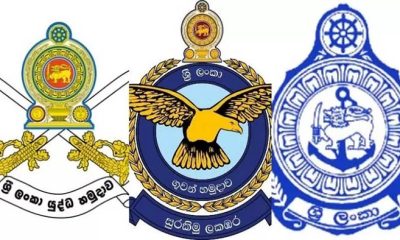
 News5 days ago
News5 days agoService chiefs won’t get extensions; scrapping of CDS Office confirmed
-
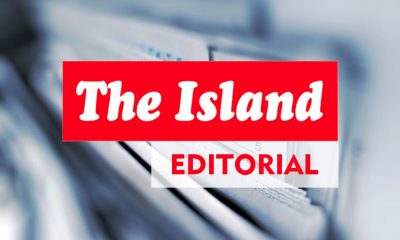
 Editorial6 days ago
Editorial6 days agoGood riddance!
-
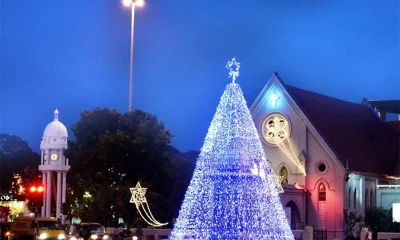
 Features2 days ago
Features2 days agoThe recovery has begun
-

 Business4 days ago
Business4 days agoSupporting the Increase in Withholding Tax: A Step Toward Strengthening Sri Lanka’s Tax System
-
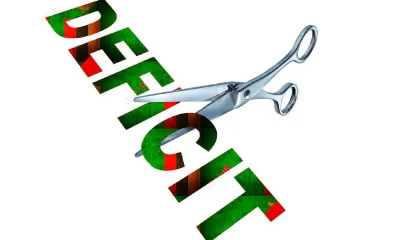
 Business3 days ago
Business3 days agoSri Lanka budget deficit decreased by Rs. 487 bn in first 10 months of 2024
-

 Editorial4 days ago
Editorial4 days agoTrimming the fat
-
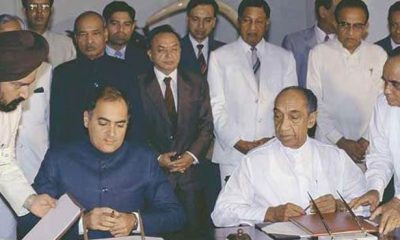
 Features4 days ago
Features4 days agoThe Parliament bomb: Former Secretary-General remembers
-
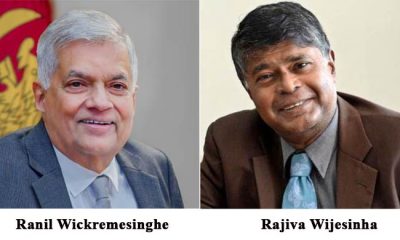
 Features4 days ago
Features4 days agoRajiva Wijesinha on Ranil Wickremesinghe


